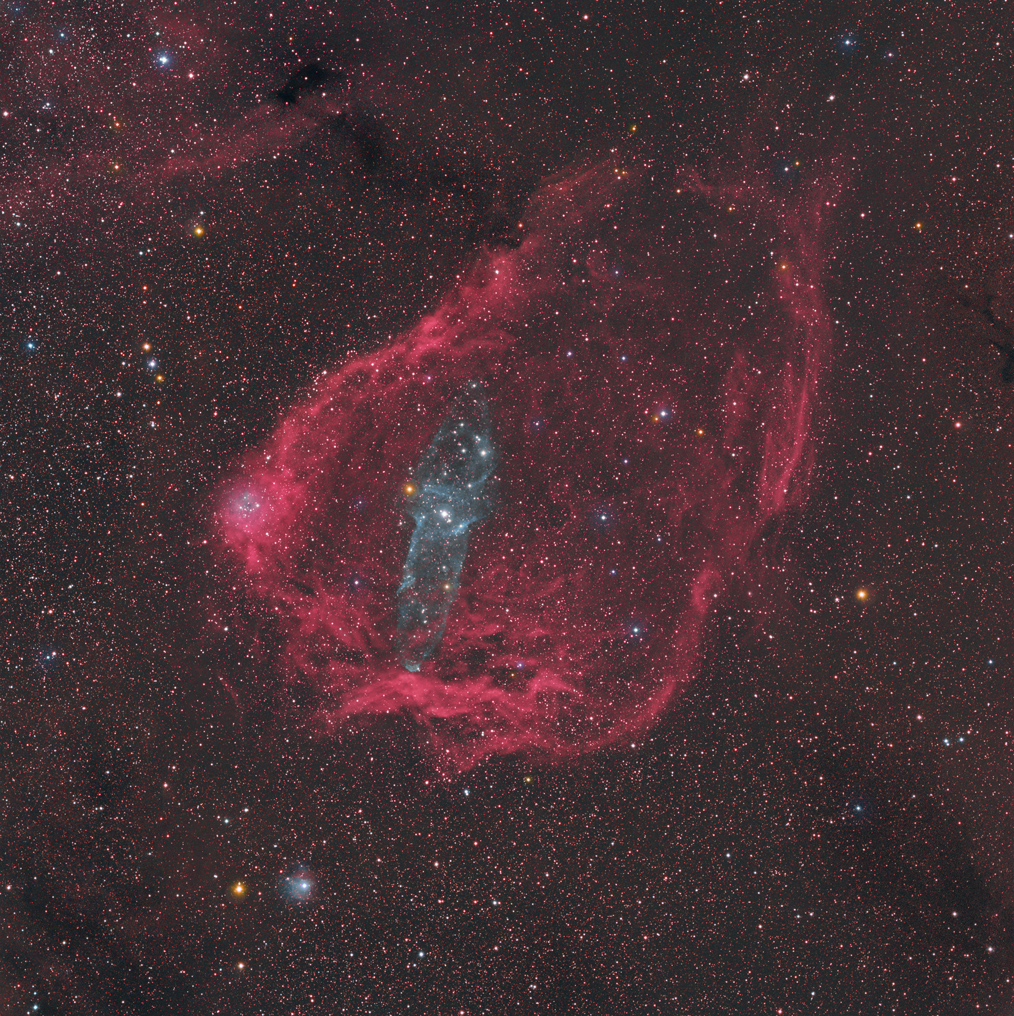SH2-129 (Flying Bat Nebula) and Ou4 (Squid Nebula)
Characteristics:
Magnitude: Not determined
Size: FOV of full frame image (4096 x 4096 pixels) = 3.9 x 3.9 degrees
Image scale: 3.5 arcsec/pixel
RA: 21h 09m 40s (J2000)
Dec: 59 degrees 58' 20" (J2000)
PA: +353 degrees
Description:
SH2-129
is a relatively faint emission nebula in Cepheus, a neighbor of the
larger and more often imaged IC 1396.
Sometimes referred to as the "Flying Bat" nebula, this region is
characterized by Ha emission as well as a small, mixed emission and
reflection nebula (vdB 140), seen in the lower portion of the field,
just to the left of center.
What is most remarkable about this region is a recent discovery made in
2011 by Nicolas
Outters, called the "Squid Nebula" due to its shape, but more
officially called Ou4. This region is characterized by a very
faint OIII emission that has a bipolar shape reminscent of a planetary
nebula, seen as the teal-colored region just to the left of center and
requiring 10 hours of imaging through an OIII filter to capture (and
could have used even more!). Although it was originally thought
to perhaps represent a planetary nebula derived from an unknown, dying
star, more recent
evidence suggests that Ou4 is located within SH2-129 itself and is
a
bipolar outflow emitting in the OIII spectrum, moving at the same rate
as SH2-129, and possibly emanating from a triple star system located in
the center of Ou4 (HR8119, visible above as the bright star in the
center of the Squid). More information about this region may be
found here.
Photographic
Details:
Dates: August 25, 26, 27, 28,
2015
Scope: Takahashi
FSQ106 at f5 on the Takahashi NJP
Mount
Autoguider: SBIG ST-402 with
60mm guidescope, focal length 227mm
Camera: Apogee U16M at -20C, with
7 position 50mm square filter wheel (Apogee FW50-7S)
Filters: Baader
narrowband
and LRGB filters, 50mm square
Exposures: Ha, 4 hours; OIII, 10 hours; RGB, total of 6
hours. Total
combined exposure (Ha, OIII, RGB) = 20 hours
Post-processing:
Calibrated, aligned, and stacked in Maxim, followed
by DDP
in ImagesPlus (IP). Further processing in Photoshop CS (16
bit format). The luminance signal in the above image represents a
composite of Ha and OIII. The RGB color is provided by R-Ha,
G-OIII, and B-OIII channels, respectively. The OIII signal from
Ou4 was very weak and required several hours of processing that
included sequential curves adjustments, selective use of screen mode
with appropriate masking, as well as mild use of noise reduction with
Noise Ninja.
Please
note: Graphics on this website
may not be reproduced without author permission.
Back to Nebulae
Home


